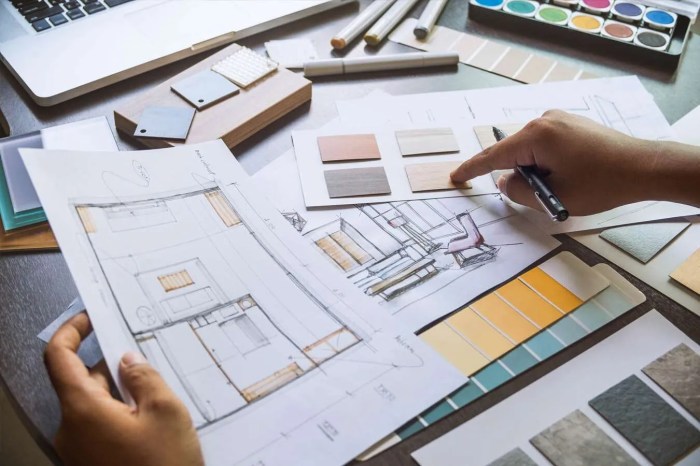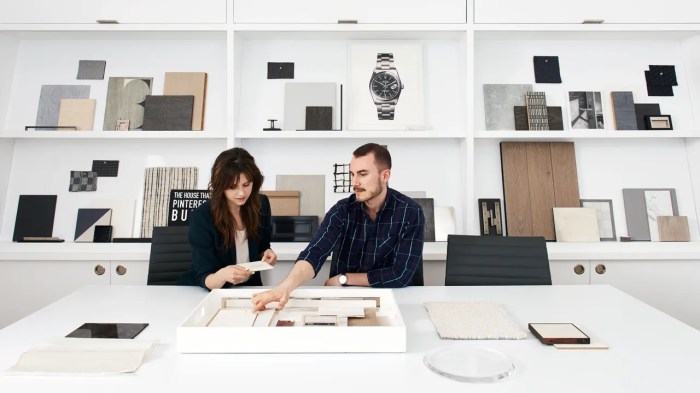Exploring the Dynamic Duo: Architect and Interior Designer
Embark on a journey delving into the world of architecture and interior design, where creativity meets functionality and innovation knows no bounds. Discover the intricate dance between these two professions as they come together to shape the spaces we inhabit.
As we unravel the layers of their collaboration, a tapestry of unique insights and expertise unfolds, painting a vivid picture of the symbiotic relationship between architects and interior designers.
Roles and Responsibilities

An architect is responsible for designing and overseeing the construction of buildings, ensuring they are functional, safe, and aesthetically pleasing. They work closely with clients to understand their needs and preferences, create detailed plans and drawings, and collaborate with engineers and contractors to bring the design to life.On the other hand, an interior designer focuses on creating functional and visually appealing interior spaces.
They work with clients to understand their style preferences and requirements, select furniture, fixtures, and finishes, and create layouts that optimize space and flow. Interior designers also consider factors like lighting, acoustics, and color schemes to enhance the overall ambiance of a space.
Collaboration in Projects
Architects and interior designers often collaborate on projects to ensure that the exterior and interior design elements complement each other seamlessly. For example, in a commercial building project, the architect may focus on the structural design and overall layout of the building, while the interior designer can work on space planning, furniture selection, and creating a cohesive design scheme that aligns with the architectural vision.Additionally, in residential projects, architects and interior designers may collaborate to create a cohesive design that reflects the homeowner's preferences and lifestyle.
The architect may focus on the building's structural integrity and exterior aesthetics, while the interior designer can bring in elements like color schemes, finishes, and furnishings to enhance the overall look and feel of the space.Overall, collaboration between architects and interior designers is crucial in creating successful projects that not only look visually stunning but also function effectively for the end users.
Their combined expertise ensures that both the architectural and interior design aspects are carefully considered and integrated to create harmonious spaces that meet the client's needs and expectations.
Education and Training

To become an architect or an interior designer, individuals typically follow a specific educational path to gain the necessary knowledge and skills for these professions. The training programs for architects and interior designers have some key differences, and there are certain certifications or licenses required to practice in these fields.
Architect Education and Training
- Architects usually start by earning a Bachelor's degree in Architecture, which typically takes about 5 years to complete.
- After completing their undergraduate studies, aspiring architects often pursue a Master's degree in Architecture, which can take an additional 2-3 years.
- Architects must also complete a period of practical training, typically through an internship or apprenticeship program, to gain hands-on experience in the field.
Interior Designer Education and Training
- Interior designers typically earn a Bachelor's degree in Interior Design or a related field, which usually takes around 4 years to complete.
- Some interior designers may choose to pursue a Master's degree in Interior Design or a specialized area within the field to further enhance their skills and knowledge.
- Similar to architects, interior designers may also participate in internships or apprenticeships to gain real-world experience before entering the workforce.
Certifications and Licenses
- Architects in the United States are required to be licensed in order to practice. This typically involves completing a professional degree in architecture, gaining relevant work experience, and passing the Architect Registration Examination.
- Interior designers may choose to become certified through organizations such as the National Council for Interior Design Qualification (NCIDQ) to demonstrate their expertise and professionalism in the field.
Design Process
When it comes to the design process, architects and interior designers follow distinct approaches based on their expertise and focus. Architects typically emphasize concept development and construction planning, while interior designers prioritize spatial planning and aesthetics
Architects’ Design Process
Architects begin the design process by understanding the client's needs and project requirements. They then proceed to develop conceptual designs, which involve creating initial sketches and renderings to visualize the overall look and feel of the project. Once the concept is finalized, architects move on to detailed design development, where they work on technical drawings, specifications, and construction documents.
Throughout the process, architects collaborate with engineers, contractors, and other professionals to ensure that the design meets all regulatory requirements and can be successfully implemented.
Interior Designers’ Design Process
Interior designers focus on creating functional and aesthetically pleasing interior spaces. They start by assessing the client's preferences, lifestyle, and budget to develop a design concept that aligns with their needs. Spatial planning is a crucial part of the interior design process, as designers need to optimize the layout of the space to enhance functionality and flow.
Once the spatial layout is determined, interior designers work on selecting materials, finishes, furniture, and accessories that complement the overall design concept. They pay close attention to details such as lighting, color schemes, and textures to create a cohesive and inviting space.
Comparison of Approaches
Architects and interior designers approach design challenges and problem-solving in different ways due to their unique areas of expertise. Architects often focus on the structural integrity, environmental impact, and overall functionality of a building, while interior designers prioritize the aesthetics, comfort, and usability of interior spaces.
However, both professionals share a common goal of creating designs that meet the needs and expectations of their clients while adhering to industry standards and regulations. Collaboration between architects and interior designers can result in holistic and well-integrated design solutions that enhance the overall quality of a project.
Collaboration and Communication
Effective communication between architects and interior designers is crucial for the success of a project. They need to work together seamlessly to ensure that the architectural design and interior decoration complement each other, resulting in a cohesive and harmonious space.
Importance of Effective Communication
Effective communication ensures that both architects and interior designers are on the same page regarding the project goals, timelines, budget, and design preferences. It helps in avoiding misunderstandings, conflicts, and delays during the project execution. Clear and open communication also allows for the exchange of ideas, feedback, and constructive criticism, leading to innovative and creative solutions.
Tips for Fostering a Collaborative Environment
- Establish regular meetings: Schedule frequent meetings to discuss progress, challenges, and new ideas.
- Define roles and responsibilities: Clearly Artikel the responsibilities of each team member to avoid overlapping or gaps in work.
- Encourage transparency: Foster an environment where team members feel comfortable sharing their thoughts, concerns, and feedback openly.
- Utilize technology: Use collaborative tools and software to streamline communication and project management processes.
- Promote respect and mutual appreciation: Recognize and appreciate the expertise and contributions of both architects and interior designers.
Examples of Successful Projects
Collaboration between architects and interior designers has resulted in numerous successful projects, such as:
- The Guggenheim Museum in Bilbao, Spain: Renowned architect Frank Gehry collaborated with interior designer Andrée Putman to create a stunning and cohesive design that showcases both architectural innovation and interior creativity.
- The Burj Khalifa in Dubai, UAE: Architect Adrian Smith worked closely with interior designer Giorgio Armani to design the luxurious interiors of the world's tallest building, seamlessly blending architectural grandeur with sophisticated interior aesthetics.
- The Louvre Abu Dhabi in the United Arab Emirates: Architect Jean Nouvel collaborated with interior designer Hala Warde to create a breathtaking museum space that harmoniously combines architectural beauty with interior elegance, enhancing the overall visitor experience.
Final Review
In conclusion, the partnership between architects and interior designers is a harmonious blend of vision and execution, where dreams take shape and spaces come alive. Together, they craft environments that not only inspire but also resonate with the essence of those who dwell within them.
FAQ Summary
What are the primary roles of an architect and an interior designer?
An architect focuses on the overall design, structure, and functionality of a building, while an interior designer specializes in creating aesthetically pleasing and functional interior spaces.
What is the typical educational path to becoming an architect and an interior designer?
To become an architect, one usually needs a professional degree in architecture and relevant work experience, while interior designers typically pursue a degree in interior design or a related field.
How do architects and interior designers approach design challenges differently?
Architects tend to focus on the structural aspects and overall building design, while interior designers concentrate on creating appealing and functional interior spaces that complement the architecture.




